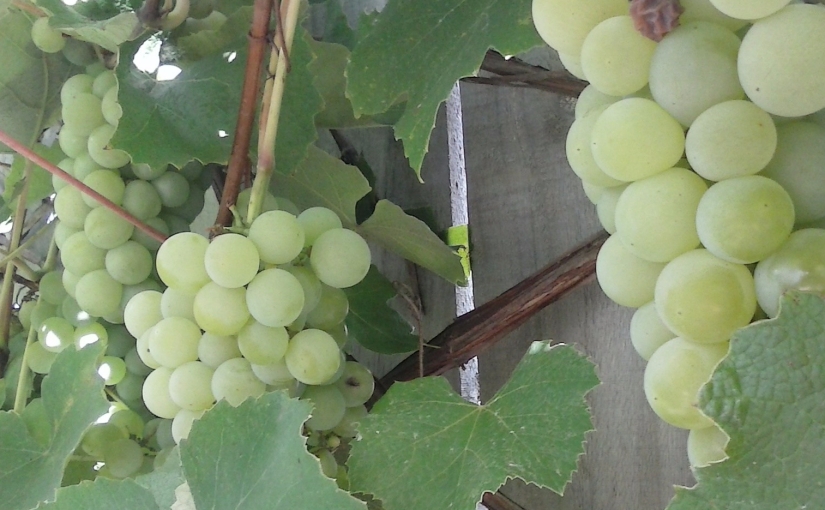It’s true, it was a grape day. It took about an hour to fully pick the one vine which runs most of the length of our driveway. I reckon we lost about half the crop to the birds earlier, but there was still plenty left. We picked them a bit earlier this year than last, which was good, I think. Not such a super-strong grapey taste, but still plenty sweet.
About 55L in all – I don’t know the weight because our bathroom scales have broken, and I wasn’t keen enough to weigh them in 2kg-at-a-time batches.
Next it was washing and pulling the grapes off the stems. I know you can crush them in bunches, but we had just too many for my little filter bag. A couple of hours of shoulder-deep squash-squishing, and we had 14L of grape juice (oh, and a few kg leftover for young friends …)
I’m using just white grapes, sans skins, for this base lot. Later, we’ll blend with the elderflower or the gooseberry (still picking those … watch this space). I’ll also use this recipe, and adjusted the gravity to suit. My juice had an SG of 1.054 to start, so I added about 1.5kg of sugar to get it up to 1.095. Being a bit of a geek, I used the calculations on this site to make my own metric sugar-addition calculator (No responsibility for calculations … they’re rough but they gave about the right SG after adding and retesting).
I didn’t have the means for testing the acidity, so have left that as is for now. With the other wines I’ve made, I’ve added calcium carbonate very late in the fermentation, and then gave it a few days more to settle before bottling. So far that’s worked ok, but I guess that the operation of the yeast might be affected by the pH too, so perhaps it would be better to test and adjust earlier on instead.
I’m using a slow fermenting yeast, CY17, which is (apparently) good for white dessert wines. Let the bubbling begin!
2.3.17 update …
The bubbling … yes … the bubbling …
Turns out the bubbling was so strong that it popped the top off our primary bucket, allowing outside contamination. A couple of days later I noticed a dozen or so bright orange spots – 5-10mm diameter – on top of the yeast foam. Not anything I could do about it, so I’ve closed it up properly (with the help of some heavy books full of light reading piled on top…) and now we just have to hope for the best. If it’s an aerobic bacteria, then it should be killed by the CO2 flush from the rest of the yeast (which is still very active). If not, well, I can only hope it tastes ok. Either way, we just have to wait and see as I don’t want to open it again to check and risk recontamination. Sigh. Most of the time I like the waiting, but not like this 😦

I’ll just leave this here for posterity … if it’s not fair to judge a book by its cover, then is it fair to judge a person by the covers which they use to weight down a recalcitrant wine primary? Truly, a question for the ages …


![CAM01566[1]](https://wildbrewing.files.wordpress.com/2017/03/cam015661.jpg?w=231&h=308)








